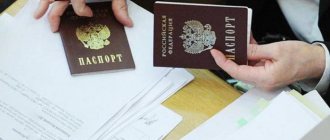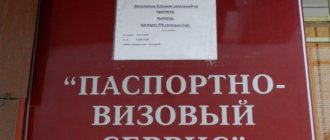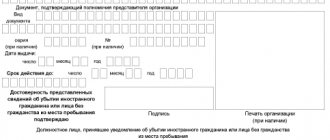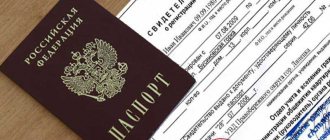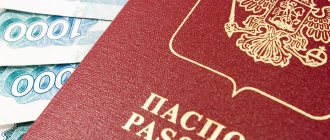The rights of people to freedom of movement within the territory of the Russian Federation are defined by Federal Law number 5242-1. Every citizen in the Russian Federation who does not live at his place of registration (in common parlance - propiska) for more than three months is required to provide evidence that he is registered at his place of temporary residence. This rule also applies to foreign students or tourists and persons who have not received “registration” for any reason. Why this is needed and where to get form 3 will be discussed below.
What's happened
Place of residence is the place of permanent residence of a person. He is tied to it with the help of permanent registration (in simple terms, “registration”), and his passport has a corresponding stamp.
If a person leaves home for a long time and lives in another place, then it is considered the place of his temporary stay.
If this lasts more than 90 days, then the citizen is obliged to declare himself to the migration service and issue a certificate of temporary registration.
Expert opinion
Klimov Yaroslav
More than 12 years in real estate, higher legal education (Russian Academy of Justice)
Ask a Question
Unlike permanent registration, when a stamp is placed in the passport, with temporary registration the applicant is issued a standard certificate, which is called Form 3 and is a separate document. Temporary registration looks like a regular certificate - A5 paper, in which the necessary data has been entered and stamped by the service that issued it. It is most reliable to store it together with your passport as an insert.
Is it possible to buy a certificate?
As long as there is demand, there will be supply. Internet sites are full of advertisements about the opportunity to buy registration in Moscow, the Moscow region (for example, in Mytishchi) or other megacities. You need to understand that such offers are the services of scammers.
Those who decide to buy a registration certificate will receive a document that is absolutely identical to the original in appearance, but is completely illegitimate. Any check will instantly reveal a fake, since the numbers of Form 3 forms are strictly recorded.
If you need to register temporarily, it is easier to pay the homeowner for the registration service in his house than to purchase false documents.
Important! If fraud and a false registration certificate are detected, criminal liability falls on both parties to the transaction: the buyer and the seller.
What is it for?
As a rule, the following citizens need temporary registration:
- Foreigners;
- stateless people;
- citizens of the Russian Federation who moved to another region for a long time.
This document allows a person to live in a particular region legally and on an equal basis with its permanent residents. Also, having a certificate opens up a lot of familiar opportunities for a citizen.
For example, an individual receives the right:
- use the services of clinics and inpatient medical institutions;
- place children in kindergarten or school;
- prepare the necessary documents;
- receive social payments and enjoy benefits;
- quickly obtain bank approval for a loan;
- apply for a job.
If the above points are not important to a person, this does not mean that he can neglect the registration of temporary registration. If a citizen lives in a place of temporary stay for more than 90 days and has not bothered to obtain a certificate in Form 3, he may be subject to administrative liability, which involves a fine of 1,500 to 2,500 rubles.
An employee of the Ministry of Internal Affairs has the right to check the presence of a certificate and, if it is not there, draw up a protocol.
Registration form 3
To better understand what registration form 3 is, you will need to look at its creation and why it was introduced.
At first, this was introduced in the Soviet Union under the name “propiska”. It was created to control the movement of citizens.
It was one of the main documents that assigned a person’s residential address, and helped with the purchase of a car, real estate and other property.
It was a mandatory document. After the collapse of the country, it was canceled because it reminded of totalitarian control.
However, there was a need to control population migration. Therefore, the term registration was introduced.
It differed from registration and had two types:
- Temporary registration.
- Registration at the residential address where the citizen stays most of the time.
The first option is form No. 3. This is a relatively new concept. Created to simplify the lives of citizens and opens many doors for its owners: from free medicine in district hospitals and getting a job in good companies.
For its absence, a fine of 1,500 to two thousand rubles is issued. If caught committing a repeated violation, they will be sent to the city where they have permanent registration.
Peculiarities
When a temporary registration is issued, the permanent one does not lose its validity - it just does not apply in another region.
Expert opinion
Klimov Yaroslav
More than 12 years in real estate, higher legal education (Russian Academy of Justice)
Ask a Question
If the applicant’s temporary place of residence is a rented apartment, then to obtain a certificate, permission from the owner of the property and his personal presence are required. The owner cannot interfere with obtaining a certificate, since he is responsible for concluding an agreement with persons who do not have registration.
The owner's permission is not required to move children into the apartment. A minor child must be registered at the place of residence of the parent.
Important! If the place of temporary stay is a hotel, hotel, sanatorium, boarding house, hospital, then the registration of the guest is carried out by the administration of the institution on the basis of the documents that the person provides upon check-in.
If a citizen of the Russian Federation can live without a certificate for up to three months, then the foreigner is obliged to take care of obtaining it within 7 days. If he is in the country as a tourist and stays at a hotel or inn, then a special registration card is drawn up for him there.
FORMS IN ELECTRONIC FORM AND ON PAPER
6.2 Organizations use document forms made on paper (forms for documents of federal government bodies with a reproduction of the State Emblem of the Russian Federation are produced by printing enterprises that have certificates of technical and technological capabilities for high-quality production of the specified type of product) and/or electronic templates of forms. Paper forms and electronic form templates must be identical in the composition of the details, the order of their arrangement, and font typefaces.
Forms of documents on paper and electronic templates of forms are produced on the basis of layouts of forms approved by the head of the organization.
Document forms should be prepared on white paper or light-colored paper.
Electronic templates of document forms must be protected from unauthorized changes.
In the context of the standard, paper document forms and electronic form templates are equivalent.
An organization, as a rule, uses both paper forms and electronic form templates (for example, for internal documents).
Important!
Forms of one type of document (for example, a letter) in paper and electronic form must be identical in terms of details and design. In other words, the form of a document of the same type on paper and its electronic template should not differ.
Another important requirement is that electronic form templates must be immutable, that is, protected from unauthorized changes.[3]
The standard emphasizes that the image of the State Emblem of the Russian Federation can only be reproduced on paper. The requirements for the production of such forms are established by Decree of the Government of the Russian Federation dated December 27, 1995 No. 1268 “On streamlining the production, use, storage and destruction of seals and forms with the reproduction of the State Emblem of the Russian Federation” (hereinafter referred to as Resolution No. 1268).
Registration requirements
If you use sample form 3, it will not be difficult to correctly fill out the document with the necessary data. The necessary columns are initially printed on the form - you just need to accurately enter everything that is required.
Each certificate is assigned an individual number and is entered into the FMS database.
The certificate must also contain the following information:
- Full name, address and date of birth of the person receiving the certificate;
- detailed information about the place of registration - full address;
- validity period of the issued document (depends on how long the person plans to live in this place);
- passport details (if the child is under 14 years old - birth certificate details).
After all this, the name and position of the employee issuing the certificate must be indicated, as well as his signature. The date of issue is indicated and the seal of the FMS department is affixed. This is what a temporary registration looks like, which must be used together with an identity document.
From the video you will learn how registration at the place of residence/stay is carried out:
What is the difference between form 3 and form 8
This question is one of the most frequently asked in the field of registration.
Their main differences:
- Form 3 (temporary registration) is issued as a certificate and has no legal force without a passport. Form 8 is inserted into the identity document itself as a stamp.
- Form 3 is issued only for a period of up to five years. After which it is canceled on its own. Form 8 is a permanent document. Only the citizen himself has the right to cancel it. This is done when changing your permanent place of residence.
- When receiving the first option, you will need to persuade the owner of the property to allow receiving this document. The second option will not require this, because in most cases it is issued for your home.
Another important point is: people who have a stamp in their passport are required to obtain Form No. 3 when visiting another city in the Russian Federation. If the period of stay in the new place exceeds 90 days. In this case, the citizen will have 2 forms at the same time.
Need to know! You can receive Form No. 8 not only in your real estate. In some cases, it is issued for the owner’s home. In such cases, a compelling reason is required. The most common document is an indefinite lease of premises.
Read when it is possible to register a child. Where can I get Form 8 about a child’s registration? More details here.
Where to get it
Obtaining a certificate is simple and the process does not take much time.
To do this you need to contact:
- the nearest MFC;
- FMS;
- Passport Office;
- Migration Service under the Ministry of Internal Affairs;
- registration department at the HOA.
You must come to one of these organizations with the necessary documents during reception hours, wait your turn and fill out an application.
In 2021, you can fill out and submit an application without leaving your home - using the State Services website.
The necessary procedures will be carried out within three days, and then the applicant will be able to receive the document.
Important! When filling out an application, a person can indicate their preferred method of receiving paper. He can either pick up the certificate himself or receive it by mail.
Is it possible to restore it in case of loss or damage and how to do it?
Registration data is stored in the information database of the Ministry of Internal Affairs, so if Form 3 was damaged or the citizen lost it, the document can be restored . To do this you need:
- Contact the registration authority where the certificate was issued.
- Upon presentation of an identity card by the applicant, the department employee issues a new certificate marked “Duplicate”.
- The registration procedure takes approximately 15 minutes, no payment for the service is required.
A certificate of registration at the place of residence is an important document for those citizens who are permanently registered in one region, but, due to circumstances, are in another subject of the Federation for more than 90 days. Registration of documents takes up to 8 days and does not require additional costs. Having a certificate greatly simplifies the life of a citizen of the Russian Federation and gives the right to legal employment, residence, training, and more.
List of documents
When submitting an application, you must provide a number of documents; for citizens of the Russian Federation, the list is limited to the following:
- identity card (both of the registered person and the owner of the residential premises);
- consent to registration;
- statement;
- documents confirming the right to registration (lease or social tenancy agreement).
The list is small and collecting the necessary papers is not difficult. The only possible problem is the need to bring the owner of the rental property with you. Not all tenants immediately agree to go through this procedure.
Who has rights
This is one of the main questions when obtaining a certificate confirming your actual place of residence. The fact is that when submitting papers to the relevant authorities, the main document is confirmation of the basis for registration.
Considering that it is received in someone else’s real estate, in the vast majority of cases they present a lease agreement for this premises. This paper must indicate the end of the lease term. This date is the end of the term of form No. 3.
Validity
When filling out the document, its validity period is indicated. A citizen can obtain temporary registration for a period of 3 months to 5 years. For a foreigner, temporary registration is valid for no more than a year.
Expert opinion
Klimov Yaroslav
More than 12 years in real estate, higher legal education (Russian Academy of Justice)
Ask a Question
The period is set depending on the personal agreement between the citizen and the owner of the place in which he will temporarily reside. It all depends on how long the owner is willing to provide his home for the use of another person.
The use of an expired certificate is equivalent to its absence and is punishable by a fine. After the expiration of the period, the citizen is obliged to contact the FMS again and obtain a new certificate. To avoid problems, this must be done immediately.
Important! You must take care of obtaining or extending your temporary registration in advance, as the procedure will take at least 3 days.
CENTERED AND FLAGGED POSITION OF DETAILS
6.5 Details 01, 02, 03 are located on the top field of the document above detail 05 in the middle of the zone occupied by this detail.
Attribute 03 can be located on the left at the level of attribute 05.
Details 05, 06, 07, 08, 09, 13, limit marks for details 10, 11, 12 within the boundaries of the location zones of the details are placed in one of the following ways:
— centered (the beginning and end of each line of details are equally distant from the boundaries of the area where the details are located);
— flag (each line of details starts from the left border of the area where the details are located).
These provisions of the standard repeat the old GOST R 6.30-2003 and offer two ways to register details within the zones of their location:
• centered (in the center of the details location area);
• flag (along the left border of the zone).
The standard also indicates that details 01 “State emblem of the Russian Federation (coat of arms of a constituent entity of the Russian Federation, coat of arms (heraldic sign) of a municipal entity)", 02 “Emblem” and 03 “Trademark (service mark)” are located in the upper field of the document according to in the middle of the zone occupied by attribute 05 “Name of the organization - the author of the document” (Example 4). However, attribute 03 can also be placed on the same level as the attribute “Name of the organization - the author of the document” (Example 5).
Can they refuse?
Most citizens receive a registration certificate without any problems - it is in the interests of the department to facilitate its registration, and not to hinder it. However, there are several reasons why a certificate may be refused.
Among them are the following:
- the applicant did not provide all documents;
- any of the documents turned out to be invalid;
- the application was filled out incorrectly;
- the premises are not intended for living;
- the premises were seized.
These are common reasons why applications are denied. If all the shortcomings are eliminated, you can repeat the procedure and obtain registration without any problems.
Receipt through intermediaries
It is not always possible for citizens living outside their primary place of residence to register temporarily with relatives, friends or rented housing. In such cases, it becomes necessary to contact intermediary companies or look for owners who provide registration for a certain fee.
When purchasing such a registration, you need to be extremely careful, since there is a risk of paying a considerable amount and purchasing a fake document .
Then, instead of solving registration problems, you will get new ones.
It is better to first consult with friends who have used the services of a company.
A registration certificate is a necessary document , and it is necessary to delay obtaining it when living for a long time in a foreign city.
By registering it, you will receive all social rights and at the same time save yourself from problems with migration authorities.
TYPES OF FORMS
6.6 The following types of organizational document forms are established:
- general form;
— letter form;
— a form for a specific type of document.
The regulatory legal acts of the organization establish the types of forms used and their varieties (letter form from structural units, letter form from an official, order form, instruction form, protocol form, etc.).
Samples of document forms are given in Appendix B.
The composition of the types of forms has not changed. However, a provision has emerged that the list of types of forms used in the organization must be enshrined in the local regulatory act (LNA) of the organization. This can be an instruction for the organization's office work or an order from the manager, which simultaneously approves the types of forms used and their samples (layouts).
